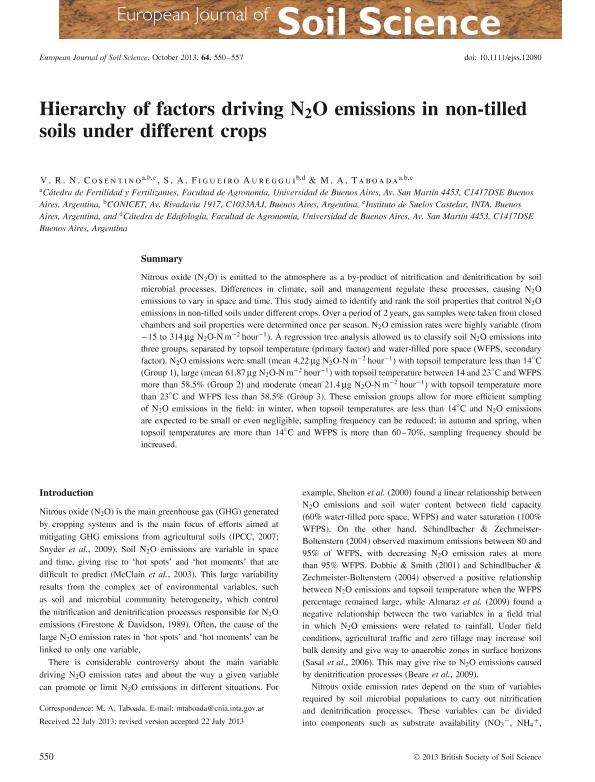Artículo
Hierarchy of factors driving N2O emissions in non-tilled soils under different crops
Fecha de publicación:
08/2013
Editorial:
Wiley
Revista:
European Journal Of Soil Science
ISSN:
1351-0754
e-ISSN:
1365-2389
Idioma:
Inglés
Tipo de recurso:
Artículo publicado
Clasificación temática:
Resumen
Nitrous oxide (N2O) is emitted to the atmosphere as a by-product of nitrification and denitrification by soil microbial processes. Differences in climate, soil and management regulate these processes, causing N2O emissions to vary in space and time. This study aimed to identify and rank the soil properties that control N2O emissions in non-tilled soils under different crops. Over a period of 2 years, gas samples were taken from closed chambers and soil properties were determined once per season. N2O emission rates were highly variable (from −15 to 314 µg N2O-N m−2 hour−1). A regression tree analysis allowed us to classify soil N2O emissions into three groups, separated by topsoil temperature (primary factor) and water-filled pore space (WFPS, secondary factor). N2O emissions were small (mean 4.22 µg N2O-N m−2 hour−1) with topsoil temperature less than 14°C (Group 1), large (mean 61.87 µg N2O-N m−2 hour−1) with topsoil temperature between 14 and 23°C and WFPS more than 58.5% (Group 2) and moderate (mean 21.4 µg N2O-N m−2 hour−1) with topsoil temperature more than 23°C and WFPS less than 58.5% (Group 3). These emission groups allow for more efficient sampling of N2O emissions in the field: in winter, when topsoil temperatures are less than 14°C and N2O emissions are expected to be small or even negligible, sampling frequency can be reduced; in autumn and spring, when topsoil temperatures are more than 14°C and WFPS is more than 60–70%, sampling frequency should be increased.
Palabras clave:
Soil N2o Emissions
,
Soil Temperature
,
Water Filled Porosity
,
Nitrates
Archivos asociados
Licencia
Identificadores
Colecciones
Articulos(SEDE CENTRAL)
Articulos de SEDE CENTRAL
Articulos de SEDE CENTRAL
Citación
Cosentino, Vanina Rosa Noemi; Figueiro Aureggi, Santiago Andres; Taboada, Miguel Angel; Hierarchy of factors driving N2O emissions in non-tilled soils under different crops; Wiley; European Journal Of Soil Science; 64; 5; 8-2013; 550-557
Compartir
Altmétricas




